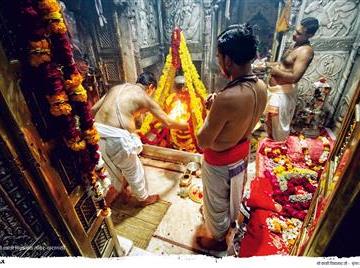 Kashi Vishwanath Temple:
Kashi Vishwanath Temple:
Shri Kashi Vishwanath Temple is a major sacred attraction, dedicated to Lord Shiva, the presiding deity of the city. The temple houses a Shivalinga, which is said to be one amongst the twelve Jyotirlinga, the fiery pillar of light, by which Lord Shiva beckoned his divine supremacy, broke through the earth’s crust and gleamed towards the heaven. The present temple was built by Rani Ahailya Bai Holkar of Indore in the year 1776, however, Shri Kashi Vishwanath Temple was existent even before the present one. About 800 kg of gold being used to cap the spire by Maharaja Ranjit Singh, hence it is also known as the Golden Temple in Varanasi. The temple has been built and re-built several times over the past centuries. The temple derives its name from Kashi, another name for Varanasi. This tirth also finds mention in old religious texts like Skanda Purana. The devotional atmosphere here is almost palpable. For the pilgrim who may have travelled thousand miles, the sanctity of the temple is only heightened by the teeming crowds, chanting of mantras and the continuous ringing of bells. Within the courtyard stands many smaller shrines, and a 2.1 metre high figure of Shiva’s bull, Nandi. The aarti held here is one of the most overwhelming experiences you can have on your trip to Varanasi.
Sankat Mochan Temple: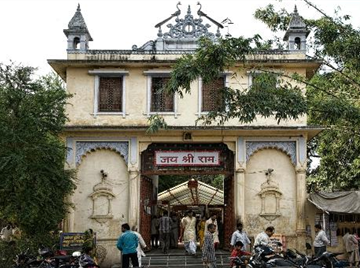 The Sankat Mochan Temple is one of the oldest temples in the city dedicated to Lord Hanuman. It is situated on the banks of Pauranic River Assi. Goswamiji has specifically named the deity "Sankat Mochan" which means reliever from troubles. In the temple, "besan ke laddoo" are served as an offering to Lord Hanuman and his idol is decked with a pleasant marigold flower garland. This temple has the unique distinction of having Lord Hanuman facing his Lord Rama, whom he worshiped with steadfast and selfless devotion It is said that Tulsidas wrote Ramcharitmanas here. According to Hindu mythology, one who visits the Sankat Mochan temple regularly gets their wishes fulfilled. It is considered that the temple was built from the time when Goswami Tulsidas had a vision of the Lord Hanuman. The temple was established by the great saint Goswami Tulsidas.
The Sankat Mochan Temple is one of the oldest temples in the city dedicated to Lord Hanuman. It is situated on the banks of Pauranic River Assi. Goswamiji has specifically named the deity "Sankat Mochan" which means reliever from troubles. In the temple, "besan ke laddoo" are served as an offering to Lord Hanuman and his idol is decked with a pleasant marigold flower garland. This temple has the unique distinction of having Lord Hanuman facing his Lord Rama, whom he worshiped with steadfast and selfless devotion It is said that Tulsidas wrote Ramcharitmanas here. According to Hindu mythology, one who visits the Sankat Mochan temple regularly gets their wishes fulfilled. It is considered that the temple was built from the time when Goswami Tulsidas had a vision of the Lord Hanuman. The temple was established by the great saint Goswami Tulsidas.
Assi Ghat: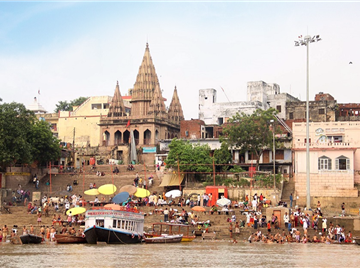 According to the ancient history, it is said that the Goddess Durga (consort of the Lord Shiva) had thrown her sword in the river (called Assi River) after killing the demon Shumbha-Nishumbha. Assi Ghat is described in the Kashi Khand as “Assi Saimbeda Tirtha” means the one who gets a dip here once in his life will get punya (blessings) of all the Tirthas (religious places of the Hindu). Generally Hindu pilgrims gather to take a holy dip here in the Chaitra (month of March/April) and Magh (month of Jan/Feb) as well as some other significant events like solar/lunar eclipse, Probodhoni Ekadashi and Makar Sankranti. At this Ghat, a huge Shiva lingam is situated under the Peepal tree where pilgrims offer Jal and worship after taking holy bath in the Ganga water. Another Shiva Lingam is - Asisangameshwar lingam, in a small temple of the marble near to the Assi Ghat. The Ghat has been also described in the ancient Hindu literatures like the Matsya purana, Kurma purana, Padma Purana, Agni purana and Kashi khanda.
According to the ancient history, it is said that the Goddess Durga (consort of the Lord Shiva) had thrown her sword in the river (called Assi River) after killing the demon Shumbha-Nishumbha. Assi Ghat is described in the Kashi Khand as “Assi Saimbeda Tirtha” means the one who gets a dip here once in his life will get punya (blessings) of all the Tirthas (religious places of the Hindu). Generally Hindu pilgrims gather to take a holy dip here in the Chaitra (month of March/April) and Magh (month of Jan/Feb) as well as some other significant events like solar/lunar eclipse, Probodhoni Ekadashi and Makar Sankranti. At this Ghat, a huge Shiva lingam is situated under the Peepal tree where pilgrims offer Jal and worship after taking holy bath in the Ganga water. Another Shiva Lingam is - Asisangameshwar lingam, in a small temple of the marble near to the Assi Ghat. The Ghat has been also described in the ancient Hindu literatures like the Matsya purana, Kurma purana, Padma Purana, Agni purana and Kashi khanda.
Durga Temple: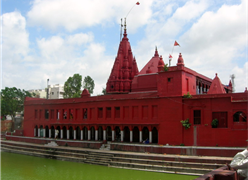 Durga temple, also known as the Monkey temple (because of the presence of huge number of monkeys), is located adjacent to Durga Kund. The temple is dedicated to the Goddess Durga and was built in the 18th century. The temple was constructed by a Bengali Maharani in the north Indian Style with multi-tiered shikhara. An attractive pond known as the Durga Kund is built on the right side of the temple which was earlier connected to river Ganga. The statue of Goddess Durga is not human made; it is believed to have appeared on its own in the temple. During the times of Navratri, a large number of Hindu devotees visit this temple. This temple is constructed in square shape with the red colour stone representing the colour of Goddess Durga. The temple lies in the south of the city, away from the Ghats. The approach is easy flanked by flower and puja paraphernalia vendors. The energy of the temple is palpable. It is considered that Goddess Durga always protects the Varanasi from problems.
Durga temple, also known as the Monkey temple (because of the presence of huge number of monkeys), is located adjacent to Durga Kund. The temple is dedicated to the Goddess Durga and was built in the 18th century. The temple was constructed by a Bengali Maharani in the north Indian Style with multi-tiered shikhara. An attractive pond known as the Durga Kund is built on the right side of the temple which was earlier connected to river Ganga. The statue of Goddess Durga is not human made; it is believed to have appeared on its own in the temple. During the times of Navratri, a large number of Hindu devotees visit this temple. This temple is constructed in square shape with the red colour stone representing the colour of Goddess Durga. The temple lies in the south of the city, away from the Ghats. The approach is easy flanked by flower and puja paraphernalia vendors. The energy of the temple is palpable. It is considered that Goddess Durga always protects the Varanasi from problems.
Kal Bhairav Temple:
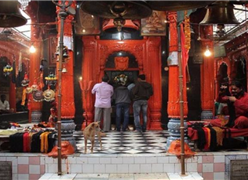 The temple is dedicated to Lord Kaal Bhairav, who is known as the 'Kotwal of Varanasi' (protector of Varanasi), it is said that without his permission no one can stay in Kashi. Bhairav is considered a fearsome manifestation of Lord Shiva who wears a garland of skulls and carries a club of peacock feathers. The name Kaal Bhairav means both Death and Fate. Even Death, it is said, is afraid of Kaal Bhairav. The door of the temple is guarded by Bhairav's mount, the dog, through which there is a fine courtyard. In the centre of the courtyard, there is the main shrine of Bhairav. His silver face, garlanded with flowers, can be seen through the doorway of inner sanctum, while the rest of the idol is said to be holdi ng a trident, seated upon a dog, hidden behind a cloth drapery. This temple was a spiritual centre in Kashi for many centuries for the utmost of Shiva ascetics. An important temple of Varanasi, it is much revered by those who live under its influence in the surrounding Kotwalpuri section of the city. It is believed if Kal Bhairav gets angry on someone, the person cannot leave Varanasi for his entire life. People who go on pilgrimage visit to Varanasi, never miss to explore the Kaal Bhairava Temple.
The temple is dedicated to Lord Kaal Bhairav, who is known as the 'Kotwal of Varanasi' (protector of Varanasi), it is said that without his permission no one can stay in Kashi. Bhairav is considered a fearsome manifestation of Lord Shiva who wears a garland of skulls and carries a club of peacock feathers. The name Kaal Bhairav means both Death and Fate. Even Death, it is said, is afraid of Kaal Bhairav. The door of the temple is guarded by Bhairav's mount, the dog, through which there is a fine courtyard. In the centre of the courtyard, there is the main shrine of Bhairav. His silver face, garlanded with flowers, can be seen through the doorway of inner sanctum, while the rest of the idol is said to be holdi ng a trident, seated upon a dog, hidden behind a cloth drapery. This temple was a spiritual centre in Kashi for many centuries for the utmost of Shiva ascetics. An important temple of Varanasi, it is much revered by those who live under its influence in the surrounding Kotwalpuri section of the city. It is believed if Kal Bhairav gets angry on someone, the person cannot leave Varanasi for his entire life. People who go on pilgrimage visit to Varanasi, never miss to explore the Kaal Bhairava Temple.
Burning Ghats: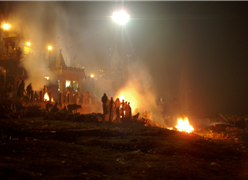 Manikarnika and Harishchandra Ghats are where you can witness the ritual of cremation from a respectful distance, giving a lifetime experience. Harishchandra Ghat is a cremation Ghat, named after the legendary king Harishchandra who is said to have lost everything in desire for self-abnegation, a king who kept honesty above everything and was reduced to work as a Dom or scavenger at the cremation ground. People in this part of the city believe that this is the oldest cremation ground in Varanasi, surpassing even Manikarnika Ghat in its, sanctity. A narrow gali from the chowk, leads you to Manikarnika, the most significant cremation Ghat of Varanasi. Hundreds of mourners and professional pall-bearers go along the alley carrying dead bodies. Guides at Manikarnika Ghat will show you the Chakrakund, a holy pool, where Lord Shiva and Goddess Parvati are said to have bathe together. Here, one can also explore the Shamshaneshwar and Kaaleshwar Mahadev Temples, and the eternal fire that has been burning here for over 3000 years. Till today, this Ghat remains wreathed in smoke.
Manikarnika and Harishchandra Ghats are where you can witness the ritual of cremation from a respectful distance, giving a lifetime experience. Harishchandra Ghat is a cremation Ghat, named after the legendary king Harishchandra who is said to have lost everything in desire for self-abnegation, a king who kept honesty above everything and was reduced to work as a Dom or scavenger at the cremation ground. People in this part of the city believe that this is the oldest cremation ground in Varanasi, surpassing even Manikarnika Ghat in its, sanctity. A narrow gali from the chowk, leads you to Manikarnika, the most significant cremation Ghat of Varanasi. Hundreds of mourners and professional pall-bearers go along the alley carrying dead bodies. Guides at Manikarnika Ghat will show you the Chakrakund, a holy pool, where Lord Shiva and Goddess Parvati are said to have bathe together. Here, one can also explore the Shamshaneshwar and Kaaleshwar Mahadev Temples, and the eternal fire that has been burning here for over 3000 years. Till today, this Ghat remains wreathed in smoke.

